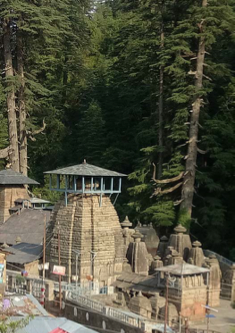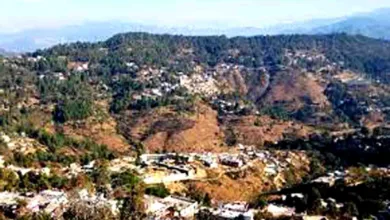HILLBILLY : Jageshwar Dham needs conservation, not exploitation

 LOKESH OHRI
LOKESH OHRI
The Himalayan State of Uttarakhand is widely known as Dev Bhumi. It is a sacred landscape where nature and culture come together to lend divinity to the mountains, valleys, lakes, rivers and alpine grasslands. Communities in this land have established familial bonds with the divine, even as their deities have protected them against the vagaries of nature.
Of the several sacred and historic sites of Uttarakhand, Jageshwar Dham is perhaps the most significant. A recent proposal to do away with many trees in the sacred forest around the site for a road project has raised alarm bells amongst the conservation fraternity, about the intentions of powers that be to exploit, and in the process destroy sites of such high spiritual and historic value as Jageshwar.
Jageshwar is an extremely significant pilgrimage centre located in the Almora district, with temples such a Mahamrityunjaya dating back to 850-950 century. It is a site of outstanding universal value, not just to the communities that live around it, but to entire humanity. Renowned for its ancient stone temples dedicated to Lord Shiva, namely the Jageshwar temple complex and the Dandeshwar temple complex, both sites are nationally protected by the Archaeological Survey of India. They were notified in the year 1915. Such is their significance that they are considered one of the twelve original Jyotirlingams, and it was customary for pilgrims on the Kailash Mansarovar pilgrimage route to stop and worship Lord Shiva here. Jageshwar is an amalgamation of two words, Jag and Ishwar, where the former means to awaken, and the latter means god or the supreme power. Therefore, this is a spot where Shiva is said to have awakened.
The site is also renowned as a centre of Lakulisha Shaivism, a revivalist sect worshipping Lord Shiva. Lakulisha, the name literally meaning club-bearing lord, was a wandering ascetic who is said to have united different sects and revived the worship of Lord Pashupati. The faith later flourished under the Bharashiva and Vakataka Dynasties of Southern and Central India. His devotees consider Lakulisha as the last of the twenty-eight incarnations of Lord Shiva, mentioned in the Puranas.
The Jataganga river and the Deodar forest around the site are themselves considered a geographical manifestation of Shiva and are therefore very significant to the sanctity of the site. The recent proposal to destroy these trees, points to a lack of awareness and official apathy towards conserving such sites that attract tourists, history buffs and pilgrims alike.
When one encounters such schemes, one is forced to think that our ancestors had a far better understanding of natural and cultural resources than contemporary ones. This can be seen in the religious practices at the temple site where ecological values were deeply ingrained or cultivated through various rituals, myths, legends or practices. For instance, the forest located behind the Jageshwar temple complex, forming its spectacular backdrop, a reserve forest as well, is locally known as Shiva Van, meaning the forests of Lord Shiva or a community resource dedicated to the lord himself. Dedicating a forest to Lord Shiva not only signifies its importance but was also an ingenious way of forest preservation such that the populace not only worshipped the natural landscape but was also afraid of cutting trees or causing any harm to it, as it was believed that the community habitation around would be doomed if any harm were to come to these lofty trees.
Brahma Kundis a natural freshwater spring at the site, lying at the lowest point of the settlement, and is the most sacred natural water source of the Jageshwar Valley. All rites of passage are conducted here, just as in Har Ki Paidi, Haridwar. It, therefore, attracts a large number of pilgrims from surrounding areas. Associating the most important water source to Brahma, ensures its cleanliness and purity. Earlier, such places where all rites of passage are conducted were avoided for residing and trading and were visited only after sunrise. Now, of course, one can see several dhabas and guest houses around.
The entire settlement is established along the banks of the rivulet Jata Ganga. This rivulet is the lifeline of the villagers. It is believed that a rock and trees over it resemble the jata or dreadlocks of Lord Shiva. Locals believe that the branches of these trees would yield milk, and this was offered to Lord Shiva for his abhisheka. However, once, a sage went on to use that milk for a large community lunch and made kheer out of it. This mass use of milk turned the sacred sap into water, thereby teaching the sage a lesson in responsible resource use.
Kedar Dhara was a waterfall originating from the hill ranges located adjacent to the Jageshwar temple complex and falling into the Jata Ganga rivulet. As per the locals, this water was used for abhisheka of Lord Shiva. Unfortunately, the waterfall has now dried up.
The mountains have always been considered sacred and people revere them as centers of the universe, abode of the gods, source of life and spaces of inspiration. Jageshwar Dham is considered the kshetrapal or the protector of this space. Deodar, an evergreen conifer long associated with the mythology of Shiva, has been encouraged and allowed to become the dominant tree species here. That many of these Deodar stands are over a millennium old suggests that the forest has long enjoyed protection. Alongside the careful enhancement of the forest cover and the rivulet’s hydrology, successive generations of ascetics and people, living in and around the Jageshwar Valley, have shaped the land by restricting personal exploitation of resources. These include refraining from building terrace fields, restricting human habitation to four hamlets, namely Mokshadham, Dandeshwar, Jageshwar, and Koteshwar, and clustering lithic monuments around two hamlets. Today, however, large resorts and cafes are mushrooming everywhere. In fact, many of the sacred Deodar trees around Jageshwar have not one single trunk but five trunks emerging from a single root. Many devotees, therefore, associate them with the Pandavas and pray to them.
It is incomprehensible how one can even think of destroying the centuries’ old well-conserved forests of Shiva at Jageshwar. Such a foolhardy act will severely impact the sanctity and the ecology of the site. Upon spending time in the Himalayan forests here, one discerns that its oaks, rhododendrons, and pines have thinned out. In those few areas where these species still abound, they either serve as visual markers of Jageshwar’s boundaries or as agents that ensure that the Jataganga has ample, flowing water year-round. The drying up of some of the water sources, however, is a dangerous sign, pointing to the impacts of construction of too many eateries and hotels around the site.
A site of such universal significance must be documented in detail and a conservation plan prepared and implemented for its preservation. If done in the right manner, the site can attract people from across the world not just for its religious value, but also to comprehend the deep, shared connections between nature and culture in Uttarakhand. An independent authority and strong Heritage Act are needed to protect sites of such universal human value to humanity.(The author is a writer, traveler and anthropologist who lives in the Himalayas; views expressed are personal)






